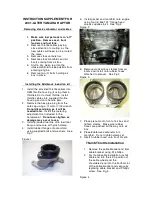
Notes on brakes
&
WARNING Risk of skidding and of an
accident due to shifting down on slippery
road surfaces
If you shift down on slippery road surfaces to
increase the engine braking effect, the drive
wheels may lose traction.
#
Do not shift down on slippery road sur‐
faces to increase the engine braking
effect.
&
WARNING Risk of accident due to the
brake system overheating
If you leave your foot on the brake pedal
when driving, the brake system may overheat.
This increases the braking distance and the
brake system may even fail.
#
Never use the brake pedal as a footrest.
#
Do not depress the brake pedal and the
accelerator pedal at the same time
while driving.
Downhill gradients
On long and steep downhill gradients you should
observe the following instructions:
R
in vehicles with an automatic transmission,
shift down to shift ranges
2 or 1 in good time
so that the engine is running at a medium to
high engine speed (
/
page 130).
R
in vehicles with a manual transmission, shift
down to a lower gear in good time, so that the
engine is running at a medium to high engine
speed.
%
Change the shift range in good time when
cruise control or the speed limiter are activa‐
ted. Observe the driving tips (
/
page 116).
You thereby make use of the braking effect of the
engine and do not have to brake as often to main‐
tain the speed. This relieves the load on the
service brake and prevents the brakes from over‐
heating and wearing too quickly.
Heavy and light loads
&
WARNING Risk of accident due to the
brake system overheating
If you leave your foot on the brake pedal
when driving, the brake system may overheat.
This increases the braking distance and the
brake system may even fail.
#
Never use the brake pedal as a footrest.
#
Do not depress the brake pedal and the
accelerator pedal at the same time
while driving.
If the brakes have been subjected to a heavy
load, do not stop the vehicle immediately. Drive
on for a short while. The brakes cool down more
quickly in the airflow.
If the brakes have been used only moderately,
you should occasionally test their effectiveness.
To do this, brake more firmly from a higher speed
while paying attention to the traffic conditions.
The brakes will grip better as a result.
Wet road surfaces
If you have been driving for a long time in heavy
rain without braking, there may be a delayed
response when you first apply the brakes. This
may also occur after driving through a car wash
or deep water. You must depress the brake pedal
more firmly. Maintain a longer distance to the
vehicle in front.
While paying attention to the traffic conditions,
you should brake the vehicle firmly after driving
on a wet road surface or through a car wash. This
heats the brake discs so that they dry more
quickly, which protects them against corrosion.
Limited braking effect on salt-treated roads:
R
a layer of salt on the brake discs or brakepads
can increase braking distances considerably,
or braking may happen on only one side
R
maintain an especially large safe distance to
the vehicle in front
To remove the layer of salt:
R
apply the brakes from time to time, paying
attention to traffic conditions
R
carefully depress the brake pedal at the end
of a journey and after the start of a new jour‐
ney
New brake discs and brakepads
New brakepads and brake discs only reach their
optimal braking effect after approximately
100 km.
Until then, compensate for the reduced braking
effect by applying greater pressure to the brake
pedal. For safety reasons, Mercedes-Benz recom‐
mends that you only have brakepads and brake
Driving and parking 119
















































